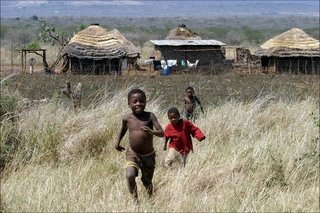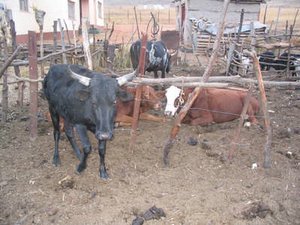Fish-N-Chips

One million calories. Two dollars. Quite tasty. Travel at least a thousand miles to visit me, and I'll buy. -Ryan

Labels: Photos and "shorts"
A pediatrician named Ryan Phelps from Denison, TX tells tales about his work in Swaziland with the Baylor International Pediatric AIDS Initiative, among other things.


Labels: Photos and "shorts"

“Look out, Sister Mamba!” one of the nurses shouted.
I had never hit a nun in the head with a chair, and was at dire risk of ruining my perfect record. We were trying to fit two dozen human bodies in a room designed for a half dozen, and we were short on chairs. To move furniture in the crowded room, I had to hold it above my head and above the veiled head of one particular elderly, paradoxically-named, surprisingly tall nun.
I am not entirely sure of what I was daydreaming about at the time, only that I was daydreaming. I remember noticing the view from the training room, and how it reminded me of the western North Carolina except all of the pines were planted by a timber company for harvest. I remember seeing a photo of the king on the conference room wall and wondering why he had three red feathers in his hair rather than two, four, or some other number. I may have been thinking about standing outside our clinic the previous afternoon and watching two toddlers chasing each other through the grass, giggling. The one in the lead was carrying a pink backpack over her head in what seemed a game of keep-away. I had refilled her HIV meds the week prior, and had wondered if they were in there, jostling about.
Regardless of what was distracting me, the Sister wasn’t exactly paying adequate attention either. She was talking to her coworker while walking backward toward the corner where I was shuffling steel furniture. Walking blindly in a crowded room during remodeling was risky behavior, especially for a church lady.
Still, I was definitely going to receive all blame if a collision occurred, my not being a nun and all. Knowing this, I executed a quick pivot and awkward but heroic hop, and the collision was averted. More importantly, my soul narrowly dodged eternal hell-fire yet again.
With Sister Mamba and the rest of the group safely seated, we started the day. After a brief review of the previous day, I began the next segment, a two-hour behemoth of a lecture on opportunistic infections (OIs).
I looked out over the faces of the 24 nurses and began my “brief” overview of the diseases that kill their HIV positive patients.
Though the nurses could not fast forward through my two-hour lecture, we can.
Here we go.
“HIV does not kill patients; OI’s kill patients” >>> Tuberclosis >>> Pneumocystis carinii (Pneumocystis jiroveci) >>> Lymphocytic interstitial pneumonitis >>> Candida albicans >>> Varicella zoster virus >>> HHV-8 (Kaposi’s sarcoma) >>> Cryptosporidium parvum >>> Cytomegalovirus >>> Mycobacterium avium-intracellulare complex >>> Toxoplasma gondii >>>Cryptococcus neoformans >>> “Let me wrap up with immune reconstitution syndrome, where your patients appear worse as their immune systems recover after starting ARVs.” >>> “Remember: prevention of OI’s involves careful treatment of HIV, good hand-washing, cooking food, boiling water, etc.” >>> “Any questions?”
One of the nurses in the back raised her hand.
“What if we don’t have running water?”
“Well,” I said, “that can be a challenge. When patients don’t have access to running water, I usually…”
Her hand went up again.
“…I mean if we don’t have running water in the clinic.”
“Well…um…” I had no idea how to answer the question, so I answered with a question.
“How many of you do not have running water in your clinics?”
Around a third of the hands went up.
One of the participants not raising her hand said, “We have water sometimes.”
“Okay. Raise your hand if you don’t have a reliable water supply in your clinics.”
Three quarters up.
“Damn,” I thought, realizing that I would be rotating through many of these clinics in the year(s) ahead.
As a group, we brainstormed solutions to this problem. Water tanks, homemade sanitizing hand gel, digging additional bore holes, etc.
“Any other questions?” I asked, afraid of what might be divulged. Hearing none, I quickly adjourned my portion of the morning.
---
One of my colleagues called HIV in Swaziland “an apocalypse.” Indeed, the numbers paint a frightening picture. Projections into the years ahead are scarier still, with concerns that countries like Swaziland could actually someday require repopulation.
How do you counter an apocalyptic pandemic without running water?
Later in the workshop, we discovered that most of the clinics in Swaziland also have no laboratory, and that all have very limited access to medicines, with long, unpredictable interruptions in the supply of those they do have.
We did not ask the nurses their salaries, but it is safe to say that few Swazi nurses are able to save enough to buy a car.
I wonder how these nurses feel when they walk into their own clinic and are greeted by an overflowing waiting room. In that clinic, they stand alone against an incessant flood of disease and need, at times without even a trickle of water from the sink.
When I picture this, the typical workday of a rural Swazi nurse, the word ‘underdog’ seems an understatement.
Yet, somehow, they persevere. They preserve hope.
On the fourth and final day of our training, we asked the nurses to divide into small groups and discuss the challenges faced by their individual clinics, as well as potential solutions. After doing this, they presented their ideas, and training certificates were distributed.
As the nurses stowed their diplomas and prepared to leave the cramped conference room and board the even-more-cramped public minivan that would return them to their rural clinics, Sister Mamba raised her hand.
The eyes of the room converged on her white gown. The sister had been quiet during the training sessions and the nurses were curious to hear what she had to say.
She stood.
“HIV is the challenge that will define our generation,” she said. “Our generation’s challenge is that we have much work to do. We cannot only describe the problems. We must return to our clinics and work to solve the problems. We must.”
She sat.
In the room, there was silence.
More silence.
Still more.
…probably 15 seconds total.
…20.
Sister Mamba suddenly stood again.
“That was my conclusion and it need not be challenged.”
She sat, chin held high.
The nurses in the room smiled a collective smile, and then applauded. I smiled and clapped along with them, glad I had not hit Sister Mamba in the head with a steel chair.
Labels: Other stories



Labels: Other stories


Labels: Other stories


Labels: Other stories